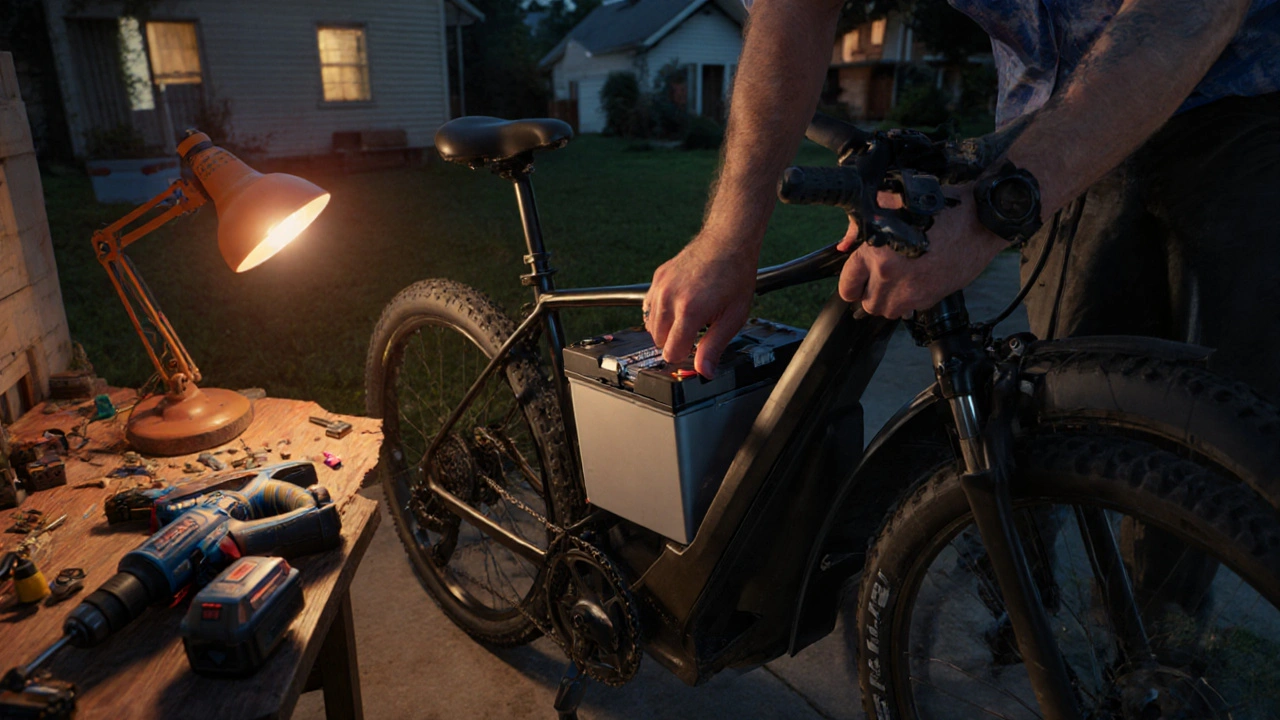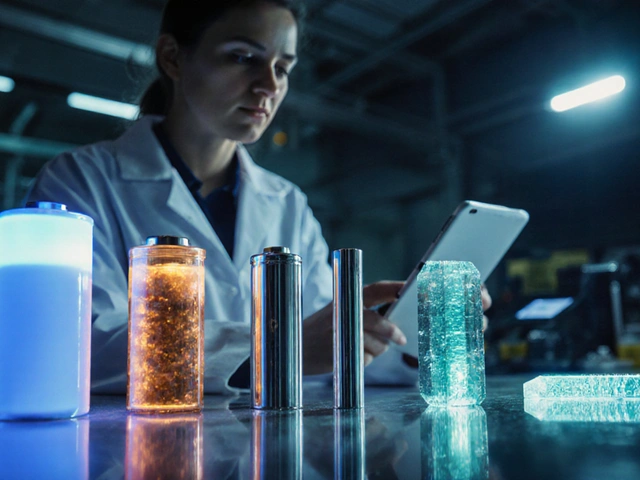Battery Chemistry Comparison Tool
Adjust Weights for Evaluation Criteria
Results
Lithium is a light alkali metal (atomic number 3) that powers the dominant rechargeable battery technology today. Its key attributes include a high specific energy (~150Wh/kg), low weight, and a voltage plateau around 3.6‑3.7V per cell. Because of these traits, lithium‑ion cells dominate smartphones, laptops and electric vehicles.
Why Compare Lithium with Other Chemistries?
Battery designers constantly chase three goals: higher energy density, lower cost, and improved safety. Lithium‑ion excels in energy density but faces raw‑material price volatility and safety concerns at high charge rates. Alternatives promise to close those gaps, but each brings its own trade‑offs. Understanding those trade‑offs helps engineers, investors and everyday gadget lovers pick the right chemistry for a given application.
Key Alternative Chemistries
- Sodium is an abundant alkali metal (atomic number 11) used in sodium‑ion batteries (Na‑ion). It offers a similar voltage to lithium (≈3.0V) and benefits from inexpensive, globally available raw materials.
- Magnesium is a divalent metal (atomic number 12) that enables magnesium‑ion batteries (Mg‑ion). Its two‑electron transfer can theoretically double capacity per ion, but sluggish solid‑state diffusion limits practical rates.
- Nickel and cobalt are transition metals frequently paired with lithium in cathodes (e.g., NMC, NCA). In alternative chemistries they appear in nickel‑metal hydride (NiMH) and nickel‑cobalt‑aluminum (NCA‑free) formats, delivering moderate energy density with robust safety.
- Solid‑state electrolyte is a class of non‑liquid ionic conductors (ceramic or polymer) that replace the flammable liquid electrolyte in lithium cells. It promises higher safety and enables lithium metal anodes for >300Wh/kg targets.
- Graphene is a single‑layer carbon sheet that can serve as a conductive additive or a novel anode material, improving charge rates and longevity.
- Lead‑acid is a mature technology using lead dioxide and lead plates in an aqueous sulfuric acid electrolyte. It provides low cost and high tolerance to abuse but suffers from low specific energy (~30Wh/kg).
- Zinc‑air relies on oxygen from the air as the cathode active material, delivering high theoretical energy density (>400Wh/kg) yet facing challenges in rechargeability and water management.
- Nickel‑Metal Hydride (NiMH) combines nickel hydroxide and a hydrogen‑absorbing alloy. It offers good cycle life and safety, commonly found in hybrid cars.
Performance Snapshot
| Chemistry | Specific Energy (Wh/kg) | Nominal Voltage (V) | Cost (USD/kWh) | Safety Rating |
|---|---|---|---|---|
| Lithium‑ion (NMC) | 150‑220 | 3.6‑3.7 | 140‑180 | Medium |
| Sodium‑ion | 90‑130 | 2.9‑3.0 | 70‑100 | High |
| Magnesium‑ion | 120‑160 (lab) | 3.0‑3.2 | ~120 | Medium‑High |
| Solid‑state Li‑ion | 200‑300 | 3.6‑4.2 | 200‑250 | Very High |
| Lead‑acid | 30‑40 | 2.0‑2.1 | 30‑50 | Low |
| Zinc‑air (rechargeable) | 250‑350 (theoretical) | 1.2‑1.4 | 80‑110 | Medium |
| NiMH | 60‑120 | 1.2‑1.4 | 90‑130 | High |
Where Each Chemistry Shines
Lithium‑ion remains the go‑to for portable electronics and most electric‑vehicle (EV) platforms because its energy density keeps weight and range in check. Manufacturers like Tesla, BYD and CATL constantly tweak NMC/NCA ratios to balance cost versus performance.
Sodium‑ion is attracting attention for grid‑scale storage where weight matters less. Companies such as Faradion and CATL have launched 100‑200Ah Na‑ion modules that can be produced with existing lithium‑ion factories, slashing capital expenditures.
Magnesium‑ion shows promise in aerospace where every gram counts and safety is paramount. Its two‑electron transfer means a single magnesium atom can store twice the charge of lithium, but researchers at the University of Texas are still working on electrolyte formulations that let Mg move quickly.
Solid‑state batteries are the hype of the next decade. Toyota and QuantumScape claim prototypes can charge to 80% in under 10minutes while eliminating fire risk. The main barrier now is scaling ceramic electrolytes without cracking during cycling.
Lead‑acid still dominates in backup power and low‑cost automotive starter batteries because the recycling infrastructure is mature and the technology is cheap.
Zinc‑air could revolutionize drones if rechargeability hurdles are solved; the air cathode eliminates the need for heavy metal oxides.
NiMH remains popular in hybrid cars (Toyota Prius) where its robustness outweighs its lower energy density.

Cost Drivers and Supply Chain Outlook
Lithium’s price spiked from $6/kg in 2015 to over $22/kg in 2023 due to EV demand and limited mining capacity in Australia and South America. In contrast, sodium is extracted from common salt brines, keeping its cost under $1/kg. Magnesium, while abundant, suffers from energy‑intensive electrolysis processes that keep its price near $2.5/kg.
Solid‑state electrolytes rely on ceramics like Li₇La₃Zr₂O₁₂ (LLZO), which command premium pricing ($150‑$200/kg). However, economies of scale could bring that down to <$50/kg by 2030.
Geopolitical factors also matter. Cobalt, a frequent lithium cathode additive, is heavily sourced from the Democratic Republic of Congo, raising ethical concerns and price volatility. Some alternative chemistries (e.g., sodium‑ion) avoid cobalt altogether, making them attractive for socially responsible investors.
Environmental and End‑of‑Life Considerations
Lithium‑ion recycling rates hover around 5‑10% globally, though Europe is pushing for 50% by 2030 with new legislation. Sodium and magnesium chemistries use less toxic metals, simplifying recycling streams.
Lead‑acid batteries boast a 95% recycling rate, making them the most environmentally friendly option in terms of material recovery, despite their low performance.
Zinc‑air cells, when designed for reuse, can be recycled with relatively low energy input, but the current market lacks large‑scale facilities.
Choosing the Right Chemistry - A Quick Decision Guide
- Portable gadgets (smartphones, laptops): Lithium‑ion (NMC/NCA) - highest energy density and mature supply chain.
- Electric cars with premium range: Solid‑state lithium (when commercially available) or high‑nickel NMC for now.
- Grid storage (hours to days): Sodium‑ion or Lead‑acid for low‑cost, high‑cycle‑life solutions.
- Aerospace or defense: Magnesium‑ion or Solid‑state for safety and weight savings.
- Hybrid vehicles: NiMH - robust, inexpensive, proven.
- High‑energy drones: Emerging Zinc‑air prototypes offer lightweight power.
Future Trends to Watch
Research labs worldwide are blending concepts - think “sodium‑solid‑state” or “magnesium‑graphene” composites - to push beyond the limits of any single chemistry. Meanwhile, policy shifts in the EU and Australia are rapidly shaping raw‑material sourcing rules, which will directly influence which alternatives become mainstream.
For anyone planning a new product or investment, the key is to map the performance envelope you need (energy, power, cost, safety) against the latest data in the table above, then consider supply‑chain resilience and regulatory risk.
Frequently Asked Questions
Is lithium still the best choice for electric vehicles?
For now, yes. Lithium‑ion cells deliver the highest specific energy among mass‑produced chemistries, keeping EV weight and range competitive. However, solid‑state lithium and high‑nickel NMC are narrowing the gap, and sodium‑ion may become viable for lower‑cost, lower‑range models in the next five years.
How does sodium‑ion safety compare to lithium‑ion?
Sodium‑ion uses a less reactive metal and typically a non‑flammable electrolyte, giving it a higher intrinsic safety rating. It’s less prone to thermal runaway, making it attractive for stationary storage where fire risk must be minimal.
What are the main challenges for magnesium‑ion batteries?
The biggest hurdle is finding electrolytes that allow Mg²⁺ ions to move quickly without forming a blocking layer on the anode. Current research focuses on halide‑based liquids and solid‑polymer electrolytes that can sustain high charge rates.
Can solid‑state batteries be manufactured at scale?
Scaling is the current bottleneck. Ceramic sheets must be thin, defect‑free, and compatible with existing roll‑to‑roll production lines. Pilot factories in Japan and the US are demonstrating 100kWh batches, but widespread commercial roll‑out likely won’t hit full volume until 2027‑2028.
Which battery type is most recyclable?
Lead‑acid leads the pack with a 95% recycling rate thanks to well‑established processes. Lithium‑ion recycling is improving, but still lags behind. Sodium‑ion and zinc‑air are easier to recycle chemically, but large‑scale facilities are not yet common.




Scott Swanson
September 27, 2025 at 12:23Oh great, another lithium hype train, because we all love watching batteries blow up, right? Let’s just keep pouring money into a technology that’s already flirting with fireworks.
Karen Gizelle
October 5, 2025 at 07:53Honestly, the whole "Lithium is king" narrative is a bit overblown. While its energy density is impressive, the volatility and cost spikes are real issues that the industry tends to gloss over. Sodium‑ion might not sound as sexy, but its raw‑material abundance could stabilize prices for grid applications. Magnesium‑ion shows promise in theory, yet practical diffusion problems still need solving. Solid‑state promises safety, but the ceramic electrolytes are expensive and fragile. We can't ignore the environmental toll of lithium mining either-water scarcity in Chile is a serious concern. If we keep chasing the highest Wh/kg without considering lifecycle impacts, we’ll end up with a new set of problems. So, maybe it’s time to broaden the conversation beyond just “more lithium”.
Stephanie Watkins
October 13, 2025 at 03:23The table you posted lays out the basics nicely. Energy density, cost, and safety are indeed the three pillars to compare.
One thing to keep in mind is that real‑world performance often deviates from spec sheets, especially under extreme temperatures.
Zachary Endres
October 20, 2025 at 22:53Wow, reading that data feels like watching a fireworks show-each chemistry sparkles in its own way!
Lithium still steals the limelight for gadgets, but sodium’s quiet reliability could light up whole power‑grid cities.
Magnesium’s double‑electron handshake sounds like a sci‑fi dream, and solid‑state may finally give us the safety we’ve been begging for.
Imagine a world where drones sip zinc‑air and never run out of juice mid‑flight-pure drama!
Amy Elder
October 28, 2025 at 17:23Sodium looks promising for grid storage.
Erin Devlin
November 5, 2025 at 12:53When we chase higher Wh/kg, we must ask: at what philosophical cost do we sacrifice safety?
Balance, not dominance, should guide our choices.
Raghav Narayan
November 13, 2025 at 08:23Let us consider the broader context in which these chemistries will be deployed.
First, the supply chain for lithium is highly concentrated in a few geographic regions, which introduces geopolitical risk.
Second, the environmental impact of extraction, particularly water consumption in arid zones, cannot be ignored.
Third, the recycling infrastructure for lithium‑ion is still nascent, whereas lead‑acid enjoys a mature loop.
Fourth, solid‑state electrolytes, while promising, suffer from brittle fracture during thermal cycling, leading to capacity fade.
Fifth, sodium‑ion’s lower voltage curve reduces system efficiency unless managed with sophisticated power electronics.
Sixth, magnesium‑ion faces a dual‑charge transfer hurdle that demands novel electrolyte formulations.
Seventh, zinc‑air’s theoretical energy is impressive, yet its rechargeability hinges on water management strategies that remain unproven at scale.
Eighth, NiMH, though safe, cannot meet the energy density demands of modern EVs without significant weight penalties.
Ninth, cost trajectories suggest that sodium‑ion could undercut lithium by 30‑40 % in the next decade, assuming raw‑material price stability.
Tenth, safety ratings, while somewhat subjective, reflect real‑world abuse scenarios that are critical for consumer acceptance.
Eleventh, standards bodies are beginning to address solid‑state certification, which will affect market entry timelines.
Twelfth, the thermal management systems for high‑energy chemistries add to overall vehicle cost and complexity.
Thirteenth, the end‑of‑life treatment pathways must be integrated early in design to avoid future regulatory penalties.
Fourteenth, a holistic view demands that we weigh energy density against durability, cost, safety, and environmental footprint.
Finally, decision‑makers should employ multi‑criteria decision analysis tools-much like the interactive slider you provided-to prioritize the attributes most relevant to their specific application.
In summary, no single chemistry is a panacea; each excels under particular constraints, and the optimal choice emerges only after a rigorous, context‑specific evaluation.
Scott Kohler
November 21, 2025 at 03:53Sure, the industry loves to wax lyrical about “innovation,” but let’s not ignore the fact that the big players are funneling funds into solid‑state to keep the status quo of profit margins. The alleged safety improvements are just marketing fluff until we see mass‑production data, and the alleged cost reductions are hidden behind NDAs. Meanwhile, the shadowy mining contracts for lithium are controlled by a select few oligarchs-nothing “new” about that.
Brittany McGuigan
November 28, 2025 at 23:23Honestly, i think the best battery for america is the one that keeps us independent from foreign supply. Lithium is dominated by china, and that’s a big problem for national security. Sodium is abundant right here in the US and can be mined locally, which makes it a better patriotic choice.
Lindy Fujimoto
December 6, 2025 at 18:53🔥 Wow, look at those numbers! 🔥
Solid‑state really does sound like the holy grail, but remember the ceramic fragility-one crack and it’s over. 😅
And sodium‑ion? It’s like the underdog hero, quietly saving the grid while nobody watches. 🌟
Let’s keep our eyes peeled for the next breakthrough-maybe a hybrid that mixes the best of both worlds! 🚀
darren coen
December 14, 2025 at 14:23I hear the concerns about lithium supply and agree that diversification is wise.
Exploring alternatives is definitely the right path forward.
Jennifer Boyd
December 22, 2025 at 09:53Thanks for sharing this comprehensive breakdown! It’s refreshing to see data presented so clearly.
Remember, every chemistry has its own sweet spot, and the key is matching the right one to the right application.
Keep the discussion going-there’s a lot more to learn together!
Lauren DiSabato
December 30, 2025 at 05:23Let’s cut the fluff: most of these “alternatives” are just marketing buzzwords until they prove themselves at scale.
Lithium‑ion still dominates because it actually works, not because it’s a hype.
Solid‑state sounds promising, but the cost curve is absurd, and we’re still waiting for a real-world demo.
Sodium‑ion’s lower voltage means you need more cells, which defeats the purpose of cheaper storage.
Bottom line: don’t get dazzled by glossy slides; demand hard data.
Hutchins Harbin
January 7, 2026 at 00:53The table you posted is a solid starting point, but let’s dig deeper.
First, energy density isn’t everything; power density and cycle life matter just as much for many applications.
Second, safety ratings are often based on limited abuse tests-real‑world scenarios can be far harsher.
Third, cost per kWh must include manufacturing overhead, not just raw material expense.
Finally, consider the integration costs-changing the chemistry often means redesigning the entire system architecture.